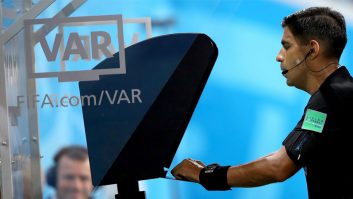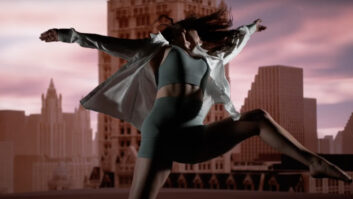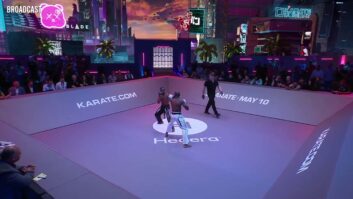To date, Liverpool-based LA Productions has produced seven series of Moving On. The UK daytime drama features contemporary self-contained stories about characters trying to ‘move on’ with their lives.
With an eighth series currently in production, we caught up with LA Productions head of post Patrick Hall to give us an overview of the Moving On workflow, with a retrospective look at series seven.
“As with all of Moving On, each series comprises five brand new individual stories, so it’s always interesting getting the scripts,” Hall recalls. “What Moving On enables us to do, and in fact what it requires, is to deliver prime time drama and production values on a much smaller budget.”
Shooting
Cameras from RED, Arri and Panasonic were deployed on the series before Hall championed the use of the Blackmagic Design URSA 4K and two models of the Production Camera 4K, on series six.

“We bought them, a set of Samyang cine primes and a Canon 70-200 outright,” says Hall. “Moving On has very tight budgets, but with the Blackmagic cameras we have been able to deliver some wonderful imagery for a fraction of the cost of hiring. The wide dynamic range is great when it comes to grading as well. We try to squeeze as much production value out of every frame as we can.”
Hall says Moving On series seven had some ‘great and quite different’ stories. “The common theme from a post and camera perspective is, how can we make this series better than the last?” he recalls.
According to Hall, the speed of the shoot and the variety of setups on each day posed the greatest challenges for the team during principle photography.
“Each director and crew have six days to shoot each episode entirely on location, so that’s always a challenge,” says Hall. “We have to be aware of who our commissioned audience is, and that we only have 45 minutes to tell our story, so the style on each episode cannot be hugely different. We use the same DoP for each episode, however each director brings their own style, and with the help of the DoP and grade we can subtly apply different styles and flavours to each story. The beauty of the Blackmagic cameras are that they provide us with choices onset, and also a great negative to grade from.”
The Blackmagic Production Camera 4K proved to be a versatile unit on set, with the crew stripping it down to just the lens and main unit for some of the shots on Series 7.
“I was the camera operator for a couple of shots on a gimbal for some of the running scenes in Episode 4,” Hall recalls. “We took it down to pretty much the bare minimum – we were just trying to reduce as much weight as possible. It was really good for those shots, because the basic footprint of the Blackmagic camera balances really well on those gimbals.”
Grading
As one of the editors on Moving On, as well as running the company’s LA Post facility, Hall obviously takes a big interest in getting the post production side right.
“The brief for the grade was to create an overall series feel that was not overly stylised, while still providing individual story looks for each episode,” he says. “We are able to pull out so much information from the Blackmagic cameras, so a large part of the grade is maximising the information in each shot and location. We are lucky to have great departments – design, costume, makeup and camera – so bringing out all their hard work in a realistic and interesting way during the grade is always nice. As with all picture grading, some of that job is to balance the images too.”
This was the first time Moving On had used Blackmagic’s DaVinci Resolve not only for the grade but the online and conform too.
“We previously used Avid DS for compositing and grading,” he explains. “When we were looking for alternative tools to do the conform and grade, Resolve seemed to be the obvious choice. We do a bounce down to Avid Media Composer and output for AS11 for the BBC, but otherwise we play out of Resolve.”
Hall continues, “There are a couple of features of Resolve that clearly work hand in hand with the Blackmagic cameras and so that makes for a very efficient workflow – for example the sun hot spot removal tool is fantastic. Another good tool is the Colour Match. It helps us check our ‘normal’ before we get on with the grade or we need to quickly balance a shot. Having said that we have used Resolve with Alexa and Canon 5D footage, as well as RED material, and it stands up really well.
“In terms of stabilisation, Resolve is far superior to most things out there and the tracking is just phenomenally fast. It’s probably saved us a day per episode in terms of time and resources. We’ve not taken that time off the schedule, we’ve built it in, to have more time for grading. We can be more creative and push things a bit more, and spend a bit more time on the episode.”
The speed of the shoot and the variety of setups on each day posed the greatest challenges for the team during principle photography
Resolving the weather
“There are a multitude of times during the edit when I said, ‘I can’t wait to get that into Resolve&rsqrsquo;, knowing that something looks good already, but is going to look fantastic once it’s been through the grade. In episode one there were a lot of beach shots, big wides with great clouds. We were able to really go to town grading that because we had such good pictures, which really helped a part of the story.”
In episode five the main issue came from shooting over six days of exteriors in really harsh sunshine, for an episode that had to be in real time.

“The lighting was very difficult for that, so we shot a lot raw in DNG so we could get a lot out of it.” Hall explains. “Having to balance those shots back into a continuous piece of work was a challenge, but Resolve’s curves editor was really good for this. We’d have up to 20 nodes on a shot and the system was playing back at 1080 in real time, really fast and responsive.”
Though delivery of Moving On to the BBC was in HD, half the time on series seven saw the Blackmagic cameras shooting in 4K in order to push in during post, or stabilise the footage. series eight however is being shot completely in 4K, and mastered on 4K for future proofing.
“Fingers crossed we get season nine,” says Hall. “Which will take us up to our 50th episode of Moving On.”







